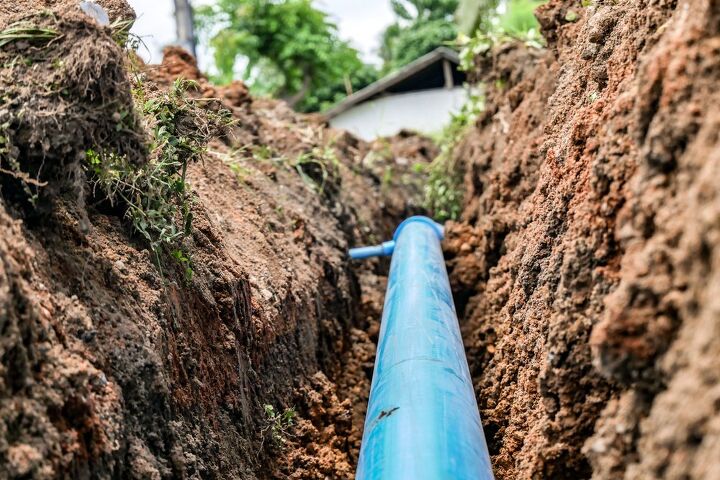How To Keep Shallow Water Lines From Freezing (Do This!)

Winter can be tough to endure for a variety of reasons. The freezing temperatures can make you uncomfortable, snow can make the roads more dangerous, and falling ill is a greater possibility. Don’t forget about how the winter can affect your home as well.
Your water supply lines become especially vulnerable during the winter. One morning, you may wake up to find that your water lines have frozen over. Note that it’s possible to avoid that inconvenient scenario.
Stop your shallow water lines from freezing by adding some kind of insulation. Specially designed pipe insulation is available, but you can also use leaves and snow. Another option involves using heating cables to stop the water lines from freezing over.
Water supply lines are susceptible to freezing during the winter. Prevent that from happening by following the tips we’ve included in this article.
Do You Need to Hire a Plumber?
Get free, zero-commitment quotes from pro contractors near you.

When Do Water Pipes Freeze?
The winter season manifests itself differently throughout the United States. Some places in the Midwest and Northeast get heavy snowfall while the South generally experiences a milder winter. Because of those varied conditions, you don’t always to worry about your water lines freezing over. So, when should you start to worry?
Water pipes start to freeze when the temperature dips to 20 degrees Fahrenheit and below. The pipes won’t freeze right away though. It usually takes around six hours for the pipes to freeze at that aforementioned temperature.
Frozen pipes are concerning not just because they block your supply of water. Once enough ice accumulates inside a pipe, it could burst. Now on top of having no water, you also have to get your water lines repaired.
No one should have to deal with the migraines that frozen water lines can potentially cause. Be proactive so you can protect your water pipes against the threat of cold temperatures.
The Different Ways to Keep Shallow Water Lines from Freezing
An effective way to stop water lines from freezing over is to bury them deep underground. You want to bury the pipes deeper than the frost line for your state so they remain in working order. Of course, not all homeowners have that option. They may only be able to bury their water supply lines under a few inches of dirt.
Shallow water lines need more help so they don’t freeze completely. The actions we’ve listed below are the ones you should take if you’re concerned about your pipes going into a deep freeze.
Close Your Garage Door
If your water supply lines run through your garage, there’s an easy way to stop them from freezing. By keeping your garage door closed at all times, you can protect your water pipes better. This isn’t a solution that works for everyone, but it’s definitely worth following if you have water pipes in your garage.
Cover the Area over the Pipes in Makeshift Insulation
One of the most effective ways to keep your home warm during the winter is to add insulation. You can do the same thing for your water supply lines.
Insulating water supply lines can be done in a few ways. The easiest way involves using items that are likely in your yard already. Gather a pile of leaves and position them over the water lines. You want to pile up as many leaves as you can in order to insulate the pipes effectively. Bust out the rake and protect your water pipes better.
You can also use snow as insulation for your plumbing. It may seem counterintuitive at first, but snow is actually a great insulator.
According to the National Snow & Ice Data Center, snow excels at insulating because of its makeup. Fresh snow has a lot of air trapped inside of it. When you use that as an insulator, it can effectively slow down the movement of heat.
Use Pipe-Wrap Insulation on the Water Lines
Leaves and piles of snow work just fine as makeshift insulators. Feel free to use them whenever you have to cover your water lines in a hurry. They also work as cost-effective counters to frozen pipes.
However, those leaves and snow piles are temporary solutions. If you want something that protects your water supply lines longer, consider purchasing some pipe-wrap insulation. Pipe-wrap insulation can be made out of different materials. Those materials include foam, foil, and rubber. Manufacturers use a combination of those materials to keep the pipes well insulated.
Cover the water lines with about two to three layers of pipe-wrap insulation to stop them from freezing. You can then use tape or wire ties to hold the insulation in place.
Also consider wrapping the insulation in plastic after securing it over the pipes. The plastic will protect the insulation from any external water. That should allow the insulation to last longer.
Surround Your Water Supply Lines with Backfill
Backfilling is a good idea if you want to keep your shallow water lines at the right temperature. Do note however that backfilling involves more than just packing some dirt into the pipe trenches.
Compacting the material used as backfill is crucial to achieving the desired results. To pull that off, you typically need to use an aptly named tool such as a compactor or perhaps an excavator. Basically, your shovel is not going to be good enough. The process of backfilling must also be done with care. Compact the material too forcefully and you could end up damaging the pipes.
If you’re opting for backfilling, you should ask the professionals to do it for you. Also, sand is a better insulator so make sure they use that as the backfill for your water supply lines.
Install Heating Cables
Heating cables that are specially designed for water pipes are now available. Those cables are designed to withstand the harshest conditions outdoors. They are also grounded in order to prevent accidents.
You can find heating cables that automatically adjust their temperature based on the conditions. That means you don’t have to monitor the cables themselves. You can just turn them on and let them do their job.
The only real downside to using heating cables is that they use electricity. They will tack on even larger numbers to your already sizable winter electric bills.
Let Water Trickle through Your Faucets
Allowing the water to continually flow through your shallow water pipes can stop the freezing process. Open your faucet just enough that you barely get a trickle of water. There’s no need to turn it on full blast.
It’s never ideal to waste water like this, but it will help counteract freezing. Use it if you want to stop the pipes from freezing as you work on longer-lasting solutions.
Drain Your Sprinkler Pipes
This last tip is not for water supply lines. Instead, you should use it on the pipes that supply water to your sprinklers.
As soon as winter gets underway, go ahead and drain your sprinkler pipes. You won’t be watering your lawn regularly during the winter so draining the sprinkler pipes won’t be an issue.
How Do You Thaw Frozen Water Lines?
Hopefully, the preventative measures detailed above did enough to stop your water supply lines from turning into long icicle containers. Unfortunately, they may not work well enough if you failed to act at the right time.
You now have to turn your attention to thawing your water supply pipes. There are easy ways to thaw those parts of your plumbing system. Simply turning your faucet on can help. Letting fresh water flow through your pipes should gradually melt their icy contents.
Another thing you can do is to warm up the pipes. Get a heating pad or some towels soaked with hot water and place them over the spot where the pipes are. You can also use a hair dryer to warm up that spot. Just avoid using anything that produces a flame. You may end up doing more harm than good that way.
If your pipes are still frozen after trying out those methods, go ahead and call a plumber. Frozen pipes are bad but burst pipes are worse. Call the plumber so you can salvage your water supply lines.
Do You Need to Hire a Plumber?
Get free, zero-commitment quotes from pro contractors near you.

Related Questions
What Are the Other Pipes inside Your Home That Are Prone to Freezing?
Aside from your shallow water lines, there are other pipes in and around your home that are prone to freezing. The pipes that run through exterior walls are especially susceptible. You need to insulate those walls if you want to protect the pipes better.Pretty much any pipe positioned in a part of your home that is not heated may freeze over. That’s why you should monitor the water pipes located in your attic, basement, and/or crawl space.
What Are the Signs That You Have Frozen Pipes?
The signs that you have frozen pipes are easy to detect. The most obvious sign is a change in water flow. Unless you were expecting a water interruption in your area, the low flow is likely due to a frozen pipe somewhere.Frozen pipes can also cause unpleasant odors to infiltrate your home. Those smells will originate from your faucets.Loud gurgling or banging sounds also hint at the presence of frozen pipes. Small chunks of ice moving through your pipes are likely producing those sounds.
Related Articles

Gary Evans is passionate about home improvement. He loves finding out how to make improvements in the easiest, most practical, and most affordable ways. Upgrading his home kitchen is one of his ongoing hobbies. Gary is also a long-time content creator and enjoys spending his free time tending to his hydroponic vegetable garden.
More by Gary Evans



























